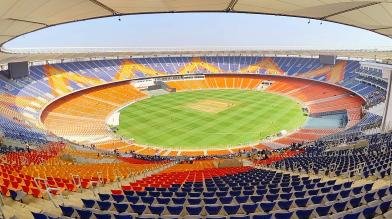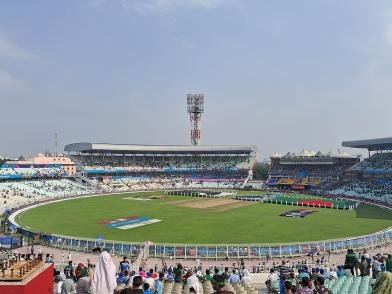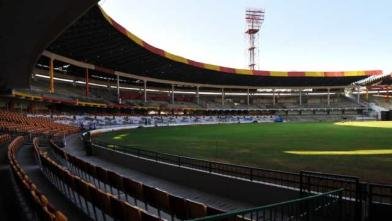Eden Gardens’ pitch, made of black cotton soil, is known for its versatility across formats, shaped by Kolkata’s humid climate and the ground’s fast-draining outfield. Below is a breakdown of its behavior in T20, ODI, and Test formats, including key trends and strategic insights.
1. T20 Format
- Pitch Characteristics:
- Batting Paradise Early: The pitch is typically flat and true, offering consistent bounce and pace, ideal for aggressive strokeplay in the powerplay. Top-order batsmen thrive, often setting high totals or chasing big scores.
- Spin in Middle Overs: By overs 6–15, the pitch slows slightly, providing grip and turn for spinners. Wrist spinners and mystery bowlers (e.g., Sunil Narine for KKR) excel in controlling run rates.
- Pace Bowling: Fast bowlers get early swing, especially in evening games under floodlights, but the pitch becomes batsman-friendly as the ball ages. Short boundaries (~62–75 meters) make it tough for pacers in death overs.
- Dew Impact: Evening dew is a game-changer, making the ball slippery and favoring chasing teams by reducing bowler grip, particularly for spinners.
- Scoring Trends:
- Average 1st Innings Score: ~155–170 (IPL/T20Is, 2018–2024). Recent IPL games have seen mammoth totals, e.g., 262/4 (PBKS vs. KKR, 2024).
- Run Rate: ~8.5 runs per over, reflecting a high-scoring venue.
- Chasing Success: Teams chasing win ~60% of matches due to dew and batting-friendly conditions.
- Conditions by Phase:
- Powerplay (1–6): Batsmen dominate with true bounce; pacers may get swing with the new ball.
- Middle Overs (7–15): Spinners gain control with turn; batsmen rely on placement over power.
- Death Overs (16–20): Dew aids big hitting; bowlers struggle for accuracy, leading to high-scoring finishes.
- Weather Influence:
- Evening humidity and dew make bowling second tougher, pushing captains to bowl first if they win the toss.
- Day games (less common) are hotter, potentially tiring fielders but offering drier conditions for bowlers.
- Strategic Notes:
- Teams pack spinners to exploit middle overs (e.g., Varun Chakravarthy, Kuldeep Yadav).
- Top-order batsmen and all-rounders are key fantasy picks.
- Short boundaries and a fast outfield reward aggressive batsmen, especially in dew-heavy chases.
2. ODI Format
- Pitch Characteristics:
- Balanced Surface: The pitch starts batsman-friendly, offering good bounce and carry for the first 20–25 overs, allowing big scores. It gradually slows, assisting spinners and challenging batsmen to rotate strike.
- Spin Dominance Later: From overs 25–40, spinners find turn and occasional low bounce, making run-scoring tougher in the middle phase.
- Pace Bowling: Pacers enjoy early movement (first 10–15 overs), particularly in day-night games under lights, with swing and bounce available. Late overs see reduced assistance.
- Dew Factor: Significant in evening sessions of day-night matches, aiding chasing teams by easing strokeplay and hampering bowlers’ grip.
- Scoring Trends:
- Average 1st Innings Score: ~240–244 (based on 39 ODIs).
- Highest Total: 404/5 (India vs. Sri Lanka, 2014, powered by Rohit Sharma’s 264).
- Lowest Total: 83 (South Africa vs. India, 2023).
- Run Rate: ~5.12 runs per over, indicating a competitive but not overly aggressive pitch.
- Win Record: Batting first wins ~59% of games, but chasing is viable in dew-affected evening games.
- Conditions by Phase:
- Early Overs (1–15): Ideal for batting; pacers get swing and bounce.
- Middle Overs (16–40): Spinners take charge as the pitch slows; batsmen focus on partnerships.
- Death Overs (41–50): Big scores possible with wickets in hand; dew boosts chasing sides.
- Weather Influence:
- Day matches favor batting first to post big totals on a fresh pitch.
- Day-night games see dew tilting the balance toward chasing, with captains often opting to bowl first.
- Humidity can tire players, affecting fielding in long sessions.
- Strategic Notes:
- Teams balance pace and spin, with new-ball pacers and middle-over spinners crucial.
- Top-order batsmen who anchor innings are vital (e.g., Virat Kohli’s consistency here).
- Dew makes defending tricky; teams aim for 270+ when batting first.
3. Test Format
- Pitch Characteristics:
- Evolving Surface: Days 1–2 offer a balanced pitch with good bounce and carry, favoring batsmen who settle in and pacers with discipline. By Day 3, it slows, and spinners begin to dominate with turn and variable bounce.
- Spin-Friendly Late: Days 4–5 see cracks and rough patches (from pacers’ footmarks), making the pitch a spinner’s dream. Batting becomes treacherous, especially in the fourth innings.
- Pace Bowling: Early assistance with bounce and occasional seam movement (Days 1–2), but pacers’ impact wanes as the pitch flattens and slows.
- Deterioration: Black cotton soil leads to uneven bounce and cracks by Days 4–5, causing sharp turn and low deliveries, testing batsmen’s technique.
- Scoring Trends:
- Average Innings Scores (recent Tests):
- 1st Innings: ~334
- 2nd Innings: ~263
- 3rd Innings: ~190
- 4th Innings: ~138
- Highest Total: 657/7d (India vs. Australia, 2013, your content notes).
- Win Record: Batting first is advantageous (~60% wins), as the pitch deteriorates, making fourth-innings chases tough. Draws occur if early batting is resilient.
- Conditions by Day:
- Day 1–2: Batsmen can build big totals; pacers get bounce and carry.
- Day 3: Pitch slows; spinners find grip, challenging new batsmen.
- Day 4–5: Spinners dominate with sharp turn and uneven bounce; batting collapses are common.
- Weather Influence:
- Winter Tests (November–February) offer stable conditions, ideal for five-day play.
- Humidity tires players; rare rain interruptions in non-monsoon months.
- Strategic Notes:
- Teams aim to bat big on Days 1–2 (e.g., VVS Laxman’s 281 in 2001).
- Spinners (e.g., Anil Kumble’s 36 wickets here) are match-winners by Days 3–5.
- Captains prioritize disciplined bowling early and spin-heavy attacks later.
- Fourth-innings targets above 200 are daunting due to pitch wear.
Join the Cric Predictor Community
Want to make the best predictions for IPL 2025? Visit Cric Predictor today to get advanced match analytics, performance insights, and expert Betting tips to stay ahead in your IPL predictions!
Get the Best Cricket Predictions and Betting Tips
Want to improve your match predictions?
Stay Ahead with Cric Predictor!
✅ Check out our latest IPL 2025 match predictions
✅Follow our Telegram Channel for exclusive updates and insights
✅Sign up for our newsletter to receive expert cricket analysis directly in your inbox
Stay tuned with Cric Predictor for all the latest updates on IPL Match schedule 2025, Match predictions, Cricket betting tips, and Betting Sites!







